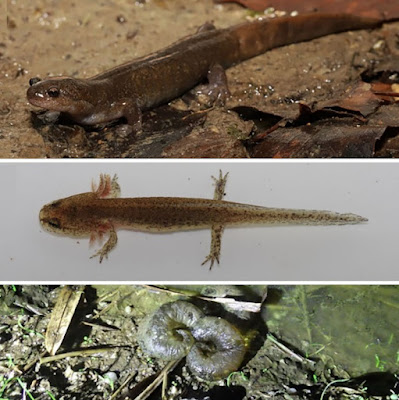 |
| Hynobius owariensis Sugawara, Fujitani, Seguchi, Sawahata & Nagano, 2022 |
Abstract
A new species of the genus Hynobius is described from the western part of Aichi Prefecture, Japan. Hynobius vandenburghi can be divided into two groups, the Aichi and Kinki groups, based on molecular and morphological analyses; thus, we described the Aichi group of H. vandenburghi as a new species, Hynobius owariensis sp. nov.. Morphological comparisons revealed that although male H. vandenburghi have distinct bright yellow lines on the dorsal and ventral sides of the tail, males of the new species do not. Additionally, in males, the new species usually has fewer costal folds between its adpressed limbs than are observed in H. vandenburghi. Other significant differences in several morphological characteristics were also found between H. vandenburghi and the new species, and results of discriminant analyses between the two species in both sexes suggested that they are separated in terms of morphological data. The new species is restricted in the western part of Aichi Prefecture, which is threatened with extinction by artificial development or reformation of well-drained paddy fields.
Keywords: Chita Peninsula, discriminant analysis, extinction, Kinki District, mitochondrial DNA
 |
| Holotype of Hynobius owariensis sp. nov. (TMNH-AM-78, adult male, 58.2 mm SVL): (A) dorsal and (B) ventral views. |
 |
| (A) Live holotype of Hynobius owariensis sp. nov. (TMNH-AM-78), and the (B) larva, (C) banana-shaped egg sacs, and (D) type locality of the new species. |
Hynobius owariensis sp. nov.
(New standard Japanese name: Owari-sanshouo)
オワリサンショウウオ
Diagnosis. A comparatively large species (mean SVL = 60.6 mm in males and 59.1 mm in females) within the Japanese lentic Hynobius species: SVL usually > 56 mm in males; ratio of hindlimb length almost always < 30 %SVL in males; distinct and bright yellow stripe on the ventral edge of tail always absent in males and almost always absent in females; distinct and bright yellow stripe on the dorsal edge of tail always absent in males; distinct black dots on the dorsum almost always absent in males; distinct white dots on the ventral and lateral sides of the body usually absent in males; DGM almost always present in males and never present in females; fifth toe of hindlimb always present; U-shaped or V-shaped vomerine teeth series; 13 (rarely 12 or 14) costal grooves; number of costal folds between adpressed limbs usually −3.0 to −1.5 in males and almost always −4.0 to −1.5 in females.
Etymology. The specific epithet “owariensis” refers to the old name of the western part of Aichi Prefecture (= Owari) where the new species occurs.
Hynobius vandenburghi Dunn, 1923
(Standard Japanese name: Yamato-sanshouo)
Diagnosis. A comparatively small species (with a
mean SVL of 53.8 mm in males and 54.3 mm in females)
within the Japanese lentic salamander species complex
of Hynobius: SVL usually < 56 mm in males; the ratio of
hindlimb length usually ≥ 30 %SVL in males; distinct and
bright yellow stripe on the dorsal and ventral edges of the
tail always present in both sexes; distinct black dots on
dorsum usually absent in both sexes; distinct gular mottling
never present in females; fifth toe of hindlimb always
present; V-shaped or U-shaped vomerine teeth series; 13
(rarely 12 or 14) costal grooves; the number of costal folds
between adpressed limbs usually > −1.5 in males and
always < −1.0 in females.
Hirotaka Sugawara, Takeshi Fujitani, Shota Seguchi, Takuo Sawahata and Masahiro Nagano. 2022. Taxonomic Re-examination of the Yamato Salamander Hynobius vandenburghi: Description of A New Species from Central Honshu, Japan. Bulletin of the Kanagawa Prefectural Museum (Natural Science). (51); 47-59. DOI: 10.32225/bkpmnh.2022.51_47


